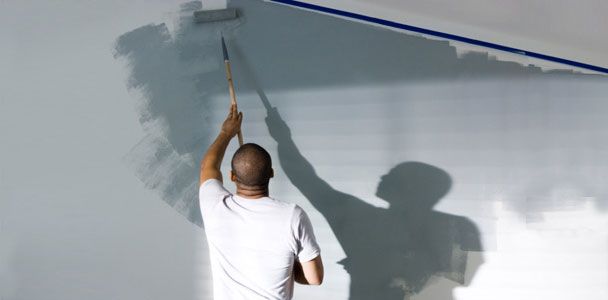Painting is one of the easiest ways to transform your home’s interior. Whether you’re refreshing a single room or tackling the entire house, proper preparation and technique are key to achieving professional-looking results. We’ll walk you through everything you need to know before picking up a paintbrush, from choosing the right paint for each room to cleaning your newly painted surfaces.
Choosing the Right Paint for Each Room
Each room has different paint requirements based on its purpose and exposure to moisture, light, and wear. Here’s what to look out for.
Kitchen and Bathroom Paint
Moisture resistance is the number one priority for kitchens and bathrooms. Choose paints specifically formulated for high-humidity areas to prevent peeling and mildew. Satin or semi-gloss finishes are ideal for these spaces, as they’re easier to clean and more resistant to moisture.
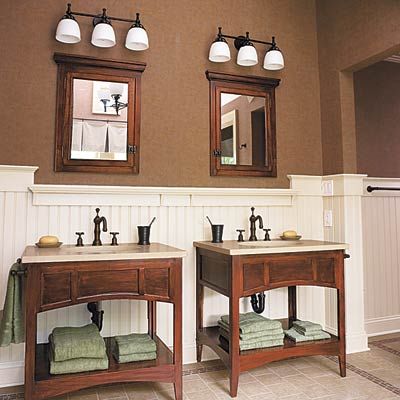
Living Room and Bedroom Paint
In living areas and bedrooms, you want long-lasting paint that’s easy to clean. An eggshell finish is popular for its subtle sheen and ability to hide minor wall imperfections. For high-traffic areas like family rooms and hallways, consider durable paint that can withstand more frequent cleaning.
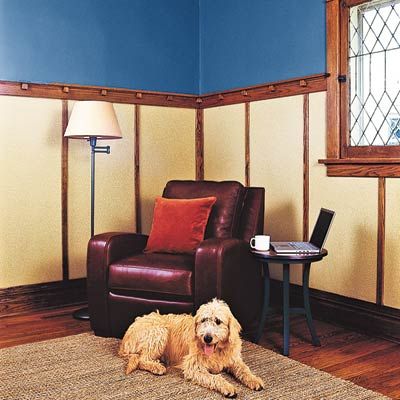
Ceiling Paint
Ceiling paint has a different formula than wall paint. It’s typically thicker to reduce drips and splatters during application. Flat or matte finishes are best for ceilings, as they help hide flaws and reduce glare from overhead lighting.
Painting Tools and Materials
Investing in quality supplies will make your painting job easier and result in a better finish.
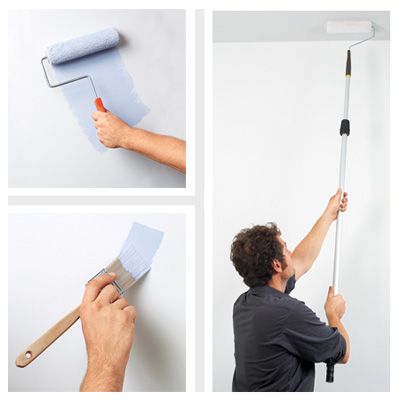
Brushes and Rollers
Choose brushes and rollers based on the surface you’re painting and the paint type you’re using. For smooth surfaces and glossy finishes, opt for brushes with synthetic bristles and rollers with a short nap. For textured surfaces and flat finishes, longer bristles and a thicker roller nap will provide better coverage.
- Smooth roller, 1/4-inch nap: Best for semigloss or gloss on smooth drywall or plaster walls.
- Semi-smooth roller, 3/8-inch nap: Best for semigloss, flat, or eggshell on lightly textured plaster or wood-paneled walls.
- Rough roller, 3/4-inch nap: Best for flat or eggshell on highly textured stucco or masonry walls.
Brushes
- 1-inch angled brush: Best for details, such as moldings and window muntins.
- 2 1/2-inch angled brush: Best for window and door casing, cabinetry, and cutting in.
- 3-inch straight brush: Best for large expanses, such as wainscoting and doors.
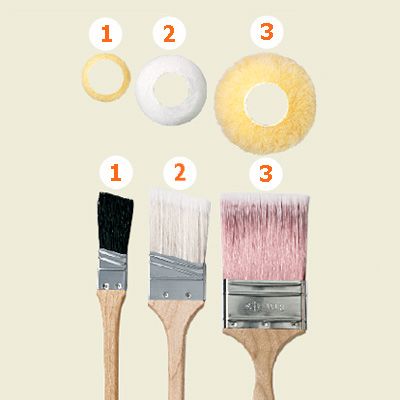
Primers and Sealants
Primers help paint adhere better to surfaces and can hide stains or dark colors. A 100% acrylic primer is versatile and works well on most surfaces. For specific needs, such as covering wood knots or blocking odors, choose a specialized primer.
Tapes and Drop Cloths
Painter’s tape is a must for achieving clean lines and protecting surfaces you don’t want to paint. Look for tapes designed to prevent paint bleed and remove easily without damaging surfaces. Canvas drop cloths are durable and reusable, making them a good tool for protecting floors and furniture.
Preparing Your Space for Painting
Take the time to prep your space thoroughly to save you time and frustration in the long run.
Room Prep Checklist
Before you start painting, follow this checklist to make sure your space is ready:
- Clean surfaces thoroughly
- Cover furniture with drop cloths
- Protect light fixtures with plastic sheeting
- Remove or cover door and window hardware
- Remove window treatments, wall art, and switch plate covers
- Sand walls and trim
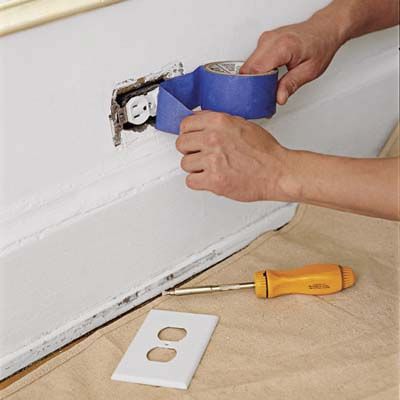
Handling Holes and Cracks
You should fix wall imperfections before painting. For small holes, use a spackling compound. For larger holes or cracks, use drywall compound and mesh tape. Once dry, sand the repaired areas smoothly to get everything even and ready to paint.
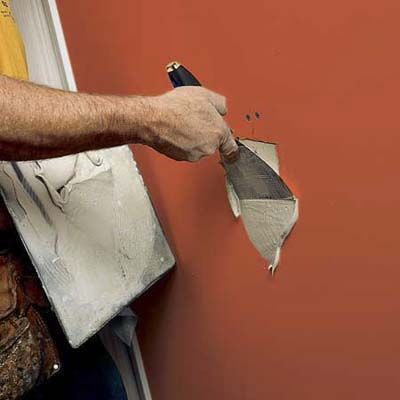
Proper Surface Cleaning
Clean your walls thoroughly before painting for the best paint adhesion. A solution of mild detergent and water works well for most surfaces. Use a degreaser for greasy kitchen areas. Allow surfaces to dry completely before painting.
Painting Techniques for Professional Results
These painting techniques will help you apply paint evenly and efficiently.
Cutting In
Cutting in refers to painting the edges of walls where they meet ceilings, baseboards, and other surfaces. Use a high-quality angled brush for precision. Paint a 2- to 3-inch wide strip along these edges before rolling the main wall areas.
Rolling Walls
When rolling walls, use a W-shaped pattern to distribute paint evenly. Start near the top of the wall and work your way down, overlapping slightly with each stroke. Maintain a wet edge to avoid lap marks.
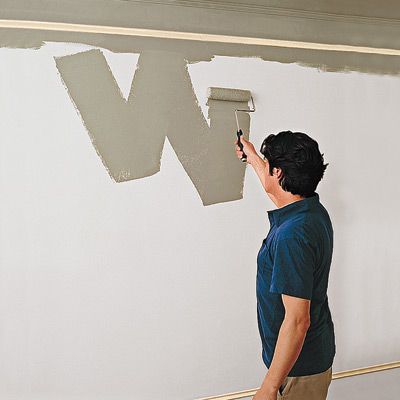
Dealing with Textured Surfaces
For textured surfaces, use a roller with a thicker nap to make sure paint gets into all the crevices. You may need to use a brush to work the paint into deep textures before rolling. Apply it in multiple thin coats for the best coverage.
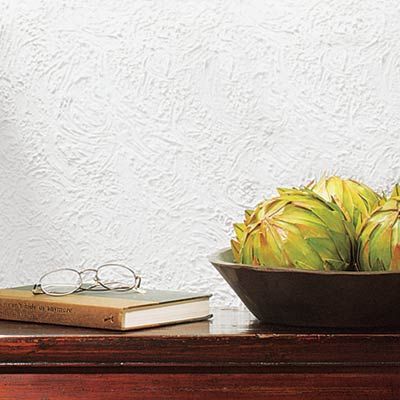
Color Selection and Finish Types
Choosing the right color and finish can dramatically change your room’s look and feel. Consider the room’s function, lighting, and your personal style when making these decisions.
Understanding Paint Sheens
Paint sheens range from flat to high gloss. Here’s a quick guide:
- Eggshell: Slightly more durable, good for living areas
- Flat/matte: Best for low-traffic areas and hiding inconsistencies
- Satin: Easy to clean, ideal for kitchens and bathrooms
- Semi-gloss and gloss: Highly durable and washable, best for trim and high-moisture areas
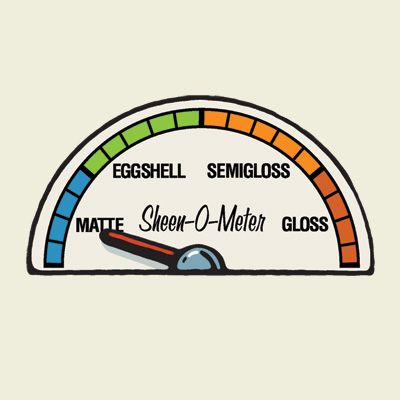
Trending Paint Colors
Color trends come and go, but neutral tones and earth-inspired hues are almost always in. Consider using bolder colors as accents or in smaller spaces for added interest.
Special Effect Paints
For unique finishes, you can choose from a variety of specialty paints:
- Chalk paints have a velvety matte finish great for furniture
- Metallic paints create a shimmering effect
- Textured paints can hide wall blemishes and look more dynamic
Painting Safety Considerations
Safety should be a top priority when painting. Take the proper precautions to prevent accidents.
Ladder Safety
When using a ladder, always do the following:
- Keep your body centered between the rails
- Maintain three points of contact at all times
- Never stand on the top two rungs
- Place the ladder on a stable, level surface
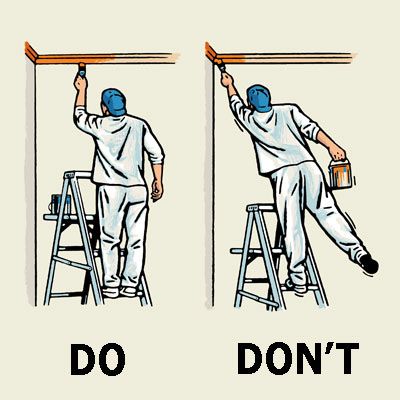
Proper Ventilation
Make sure you have good ventilation when painting indoors. Open windows and use fans to circulate air so you don’t breathe in fumes. Consider using a respirator mask, especially when working with oil-based paints or in poorly ventilated areas.
Handling and Storing Paint
Store paint in a cool, dry place away from direct sunlight and heat sources. Keep paint cans tightly sealed when not in use.
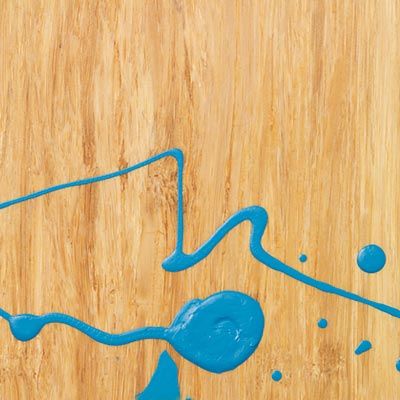
Troubleshooting Common Painting Problems
Even experienced painters encounter issues from time to time. Here are measures you can take for common painting problems:
- Addressing uneven coverage: Uneven coverage often results from not using enough paint or not allowing sufficient drying time between coats. Apply additional thin coats as needed for even coverage.
- Dealing with paint bubbles: Paint bubbles can occur due to moisture or applying paint to a dirty surface. Scrape off bubbled areas, sand smooth, clean the surface, and repaint.
- Fixing rips and runs: If you notice drips or runs while the paint is still wet, smooth them out with your brush or roller. For dried drips, sand them smooth and touch them up with paint.
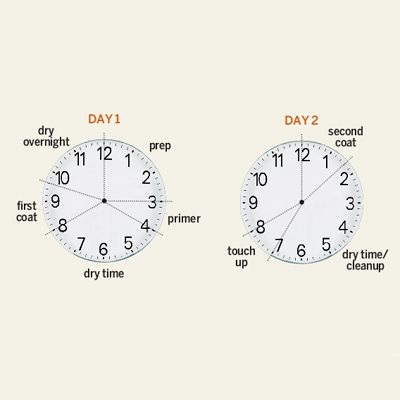
Eco-Friendly Painting Options
As awareness of environmental issues grows, many homeowners are seeking more eco-friendly painting options. Here are some tips.
- Use Low-VOC or No-VOC paints: Volatile Organic Compounds (VOCs) can be harmful to your health and the environment. Low-VOC and no-VOC paints have less emissions but don’t sacrifice quality.
- Consider natural and organic paint alternatives: Some manufacturers make paints from natural ingredients like clay, milk protein, and plant-based oils. This a good option for people with chemical sensitivities.
- Remember proper paint disposal methods: Never pour leftover paint down drains or into the ground. Check with your local waste management authority for proper disposal methods or recycling options.
Maintaining Your Painted Surfaces
Proper upkeep can extend your paint job’s life and keep your walls looking fresh for years to come.
Cleaning Painted Walls
Regular dusting and occasional washing can keep painted walls looking their best. Use a soft, damp cloth and mild soap for cleaning, and avoid harsh chemicals that can damage the paint.
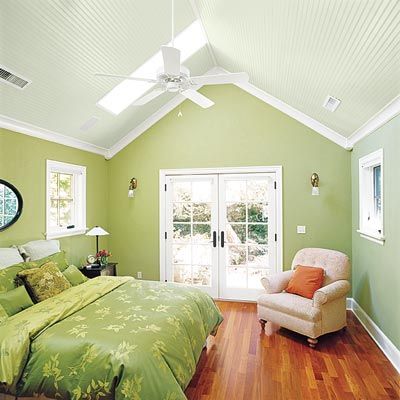
Touch-Up Techniques
Keep leftover paint for touch-ups. When touching up, use the same paint and application method as the original job for the best match.
When To Repaint
Most interior paint jobs last five to 10 years, depending on the quality of paint and level of wear. Consider repainting when you notice significant fading, peeling, or damage that can’t be addressed with touch-ups.
